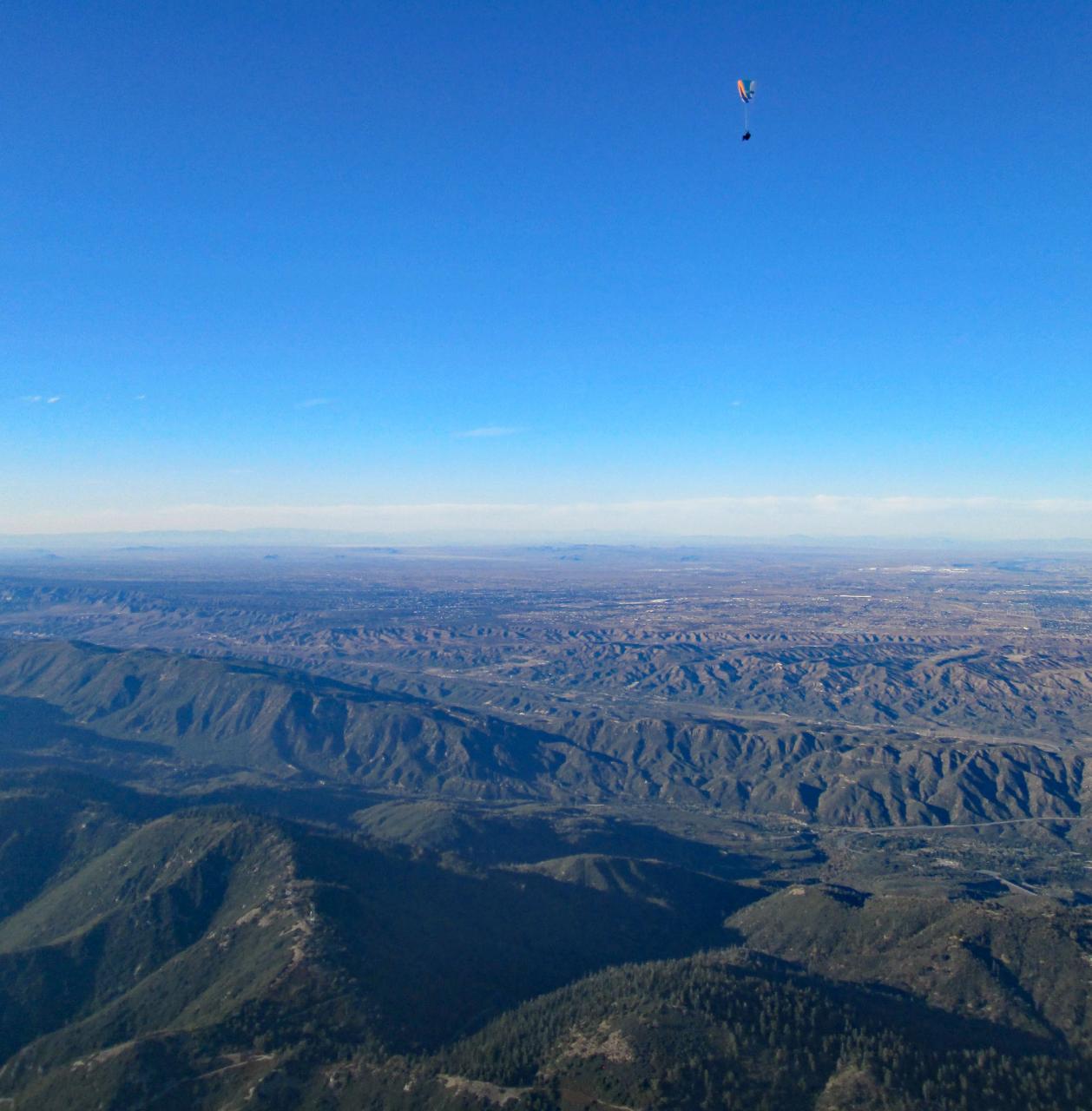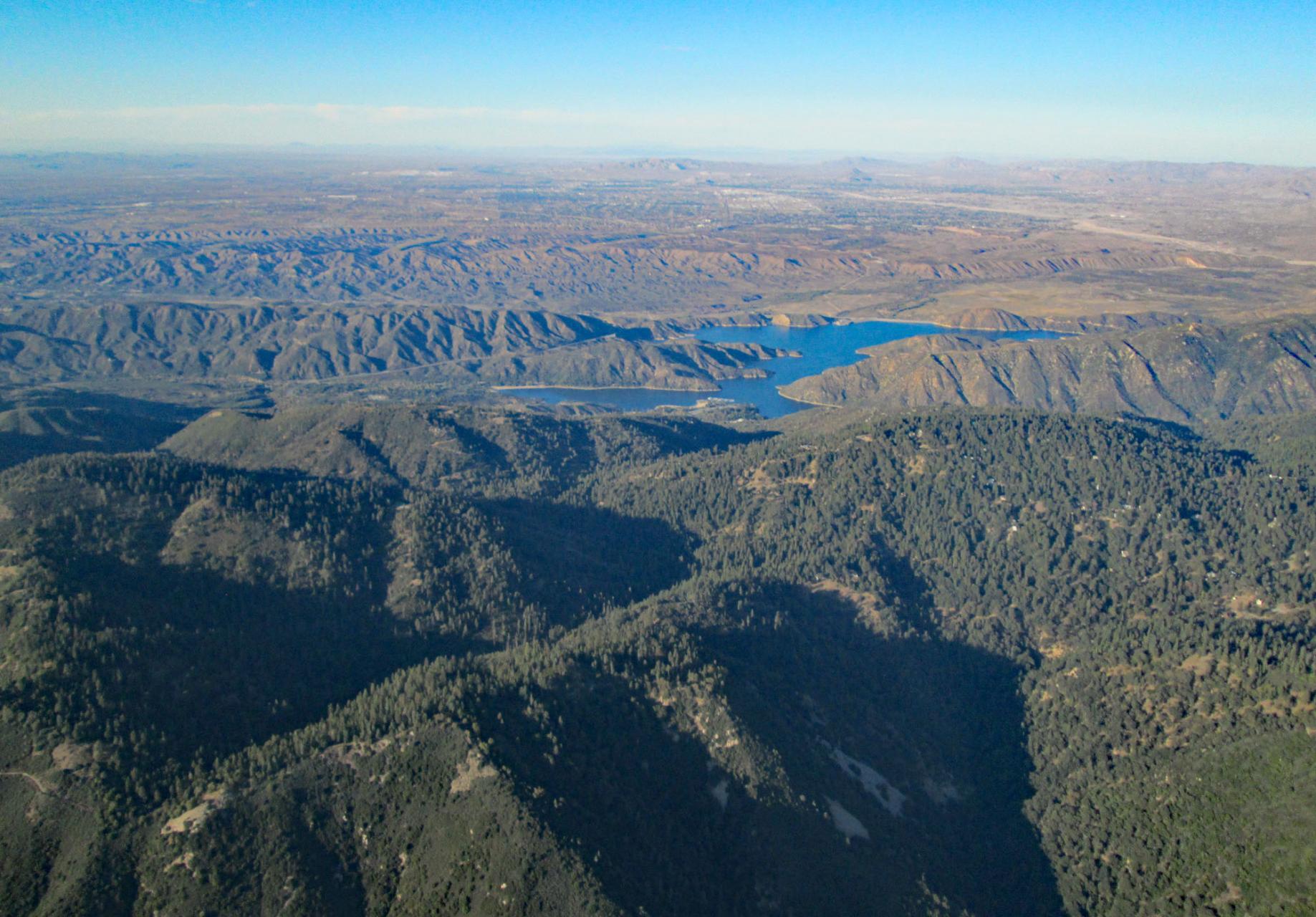Home › Forums › Pilot Reports › Thursday, 2022/10/20 – High and Floaty
- This topic has 9 replies, 6 voices, and was last updated 2 years, 9 months ago by
 David Webb.
David Webb.
-
AuthorPosts
-
October 21, 2022 at 1:20 PM #16875
 Jerome Daoust General Member
Jerome Daoust General MemberThe forecast was accurate… High altitudes mid-afternoon, light favorable wind on launches and light North above 6k.
I took the fully-loaded 2 pm Sandy van, and launched 3rd around 3 pm. Thanks to Cory for the video of my launch. I reached 9k and flew 3 hours, tagging SugarPine (to the West of Pine peak). Once high it was easy to stay high and cruise around. Just before sunset, there was a strong WNW wind about 500′ over the LZ, but the wind gradient allowed for easy landings. Thank to David for creating this animation of our flights.
Incident: Around 3:30 pm, a PG pilot deployed his reserve parachute and landed at the base of Billboard near the top of the road above the water pipelines. He radioed that he was OK and collecting his gear. But gathering his wing and reserve from the vegetation delayed his hike out. He was airlifted out that night. Takeaways: The time/effort to hike through thick vegetation on sloped terrain is often underestimated and made extra challenging after nightfall. Being on a popular radio frequency was very helpful.
David, vertical of Pine around 8k…

View of lake Silverwood, from Pine…
 October 21, 2022 at 1:34 PM #16876
October 21, 2022 at 1:34 PM #16876 David Webb General Member
David Webb General MemberDitto. More fun on a weekday than should be allowed. Had a few moments of “weird,” and lots of aircraft looky-loos. Thanks, Jerome, for the great photo.
Checking my logs, I had my personal best max altitude yesterday (8668′ MSL) and flew for just over 3 hours.
Regarding the reserve deployment – it was lucky that the pilot happened to ask on launch what frequency we would be on. If he didn’t, I don’t think anyone would have known he was down. I don’t think anyone saw the deployment (he radioed it in after he landed), and even after flying directly over his position many times with him trying to describe his position, none of us could see him, his wing, or his reserve in the thick brush. Definitely pays to be on radio (even if there’s only one other person on the other end).
October 21, 2022 at 11:14 PM #16882 John Benario General Member
John Benario General MemberI saw his collapse and the reserve throw. I was surprised how long the reserve kept him aloft. After he was on the ground I and 2 or 3 other HG pilots observed that he was moving and packing up his parachutes. I thought if he made it to the ditch just north he could walk to the water tank and the paved road. However, from altitude one has no idea how tough the vegetation is. I landed an hour later, was informed that contact had been made.
I don’t know why the PG collapsed, but it would be informative if he wrote a description of what happened to possibly help a future pilot. Additionally, relative to the 8700 ft altitude mention, remember the jets cross Crestline between 8000 and 9000 in VMC going into Ontario. Above 8000 you are in the same airspace as transport category airplanes going over 250 mph that can’t see you.
October 22, 2022 at 9:01 AM #16883 David Webb General Member
David Webb General MemberThe higher altitudes were over at Pine, but agree – start getting above 6 or 7, best to move out of the immediate area. Saw a couple at eye level that were in the 6-7 range which was unsettling.
October 22, 2022 at 5:30 PM #16887 Jonathan Dietch General Member
Jonathan Dietch General MemberSeriously, no pilot should be flying without an activated GPS tracker or a 406Mhz SARSAT beacon. The 2-meter radio is also a great idea. Better yet is for pilots to be a part of https://xcfind.paraglide.us/ and understand how to interact with the system and look for indication of incidents.
I flew with too large a glider on Thursday and paid the price. I was still able to cover a lot of terrain but got a little too ambitious and was 100′ too low by the afterbay to connect and get back up. Not matter. It was a fun flight with good views. I found a new field to land in too.
 October 22, 2022 at 8:21 PM #16888
October 22, 2022 at 8:21 PM #16888I also saw the downed PG pilot below BB and above the cistern. I circled a few times and could see him moving around and thought he must be okay, but decided it would be prudent to land and report the situation. No one in the LZ seemed overly concerned or felt the need to take action. One PG pilot radioed Marcello and told him of the situation. I later saw Gene in his UTV and told him and he replied there was not much we could do as the roads to that point were all locked and the pilot would have to walk out to a point they could pick him up.
I didn’t have a radio to hear communications from the downed pilot, but it seems an oversight for whoever did have communications with the pilot to not relay that information to the folks in the LZ. Maybe we need a club radio in the LZ with a speaker?
It would have been a bush-wacking walk for the downed pilot for maybe a half mile, but then he would have made it to good roads and an easy down hill hike to a point he could get a ride. Seems like he erred in trying to retrieve his gear rather than start walking right away while good daylight was available. Aerial rescues don’t do much for our reputation.
October 23, 2022 at 11:34 AM #16890Tim Ward
General MemberI saw him. I had to blow off a couple of thermals, but I spent half an hour or so in view. He seemed to be moving around, and the PG seemed to gradually be getting smaller, while the trampled area seemed to be getting bigger, so I desisted.
I did ask about him when I landed, and he seemed to be common knowledge by that point.October 23, 2022 at 4:37 PM #16892 David Webb General Member
David Webb General MemberA couple of us were in radio communication with the pilot and with Gene/AJX while he was working on his gear. We also relayed his GPS coordinates to the LZ.
As sunset got closer, we recommended to him that he come back for his gear the following day and start hiking down, and also gave a suggested path down to the road. Gene drove up as far up the road as he could but the gates were locked and no one on duty at the station to provide access.
Just my opinion, but I think we did all we could, and communication with both the pilot and AJX were good (even though not everyone in the LZ was up on the situation it sounds like). Perhaps he could have dropped what he was doing much earlier to start hiking out (likely the best move in this situation), but pilots in the air were in no position to make that assessment for him. Looked pretty thick from where I was sitting, but I couldn’t assess if he had a 20 minute hike or a 3 hour bushwhack ahead of him.
I think Tom’s suggestion of a radio in the LZ is a great idea. It’s come up before but hasn’t gotten traction for some reason. Even if it’s not on all the time, maybe just turning it on in the event of an incident (after the frequency for response has been made known) so that folks on the ground can monitor easily?
October 23, 2022 at 5:18 PM #16893 Jerome Daoust General Member
Jerome Daoust General MemberGlad to see a discussion being spawned from the incident. Always good to think of ways we can improve the response.
About radios… There used to be (still is ?) a radio at the North end of the container with external speaker, set to the club frequency (145.555). But I doubt many pilots use/monitor that frequency in flight.
Different idea (which I just shared with the club Safety officer and the President)… We have a visual sign for when there is an emergency and pilots need to clear the air (White X deployed in the LZ). But how about a sign that represents “We are aware of the incident/accident, it is managed, keep flying“. I propose a large checkmark. It is better than “half an X” because pilots will not confuse it with an “X” that is halfway constructed.

We can even re-use the same material of the “White X” to form this checkmark…
 October 23, 2022 at 5:32 PM #16894
October 23, 2022 at 5:32 PM #16894 David Webb General Member
David Webb General MemberI think the “half of the X” idea has come up before – seems like a simple solution (and we already have it). That is a good point about it possibly being mistaken for being half-deployed though.
-
AuthorPosts
- You must be logged in to reply to this topic.